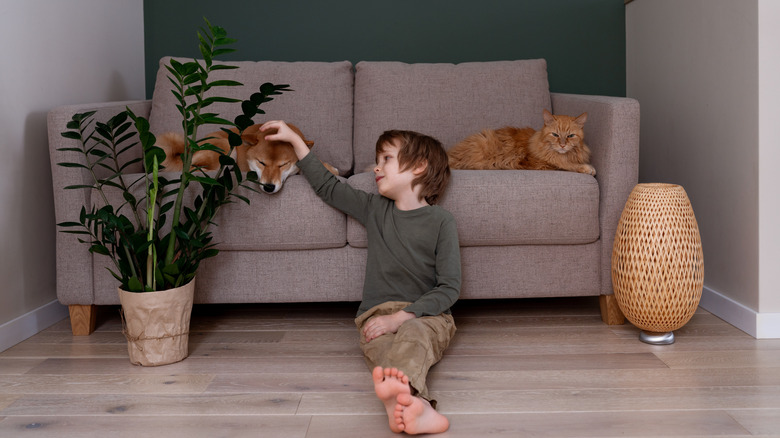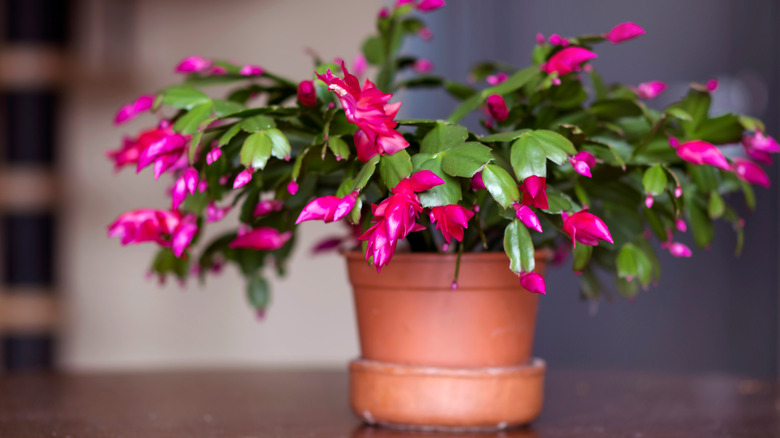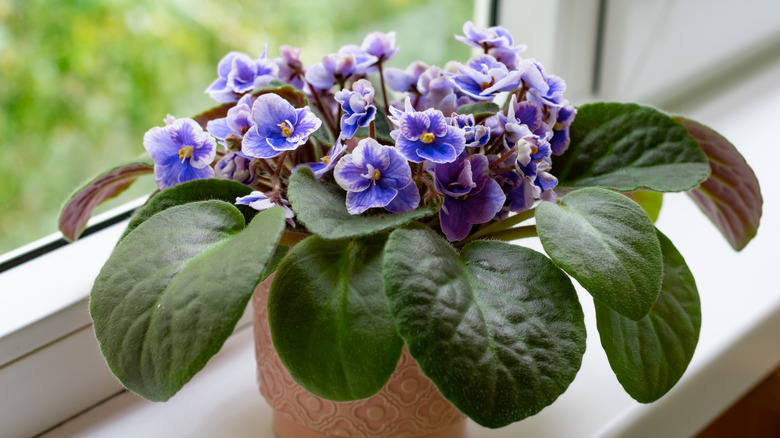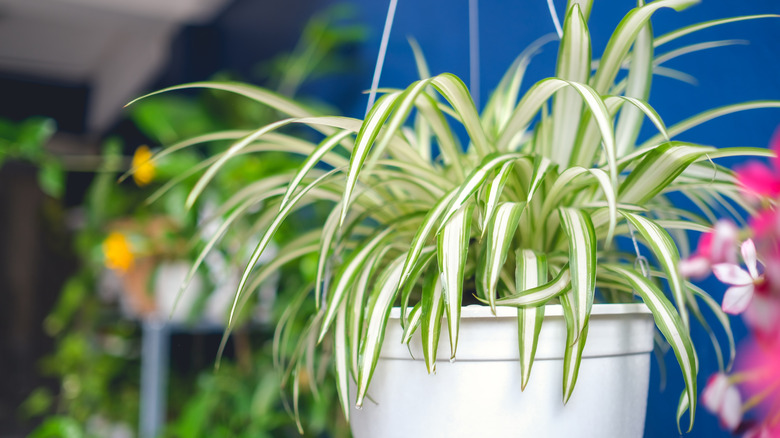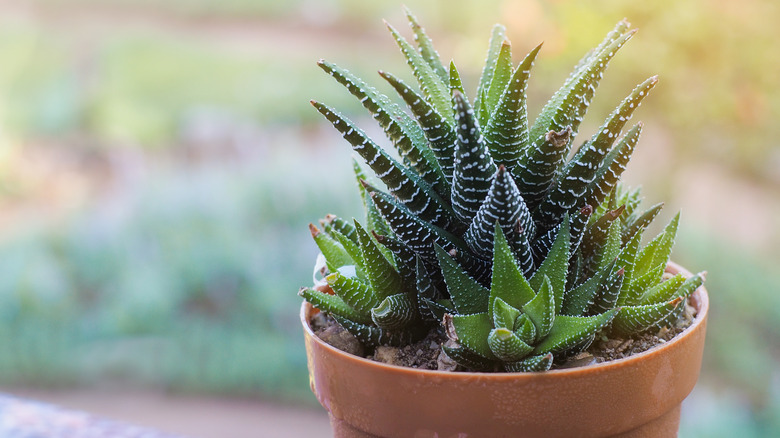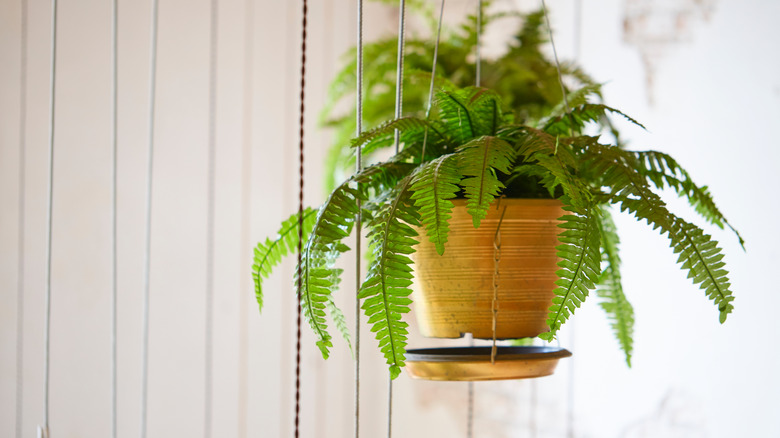5 Nontoxic Houseplants That Are Safe For Any Space
You do your best, but you cannot keep an eye on everyone all the time, and if you have small children or pets, one bite of the wrong plant can be catastrophic. The FDA states that a cat licking the pollen of a lily off its coat can result in kidney failure. When you have a family, it is vital to know what plants are safe and this information is rarely, if ever, listed on a plant tag. To keep your kiddos and furry friends safe, thoroughly research any plant you consider bringing home before making that purchase.
If the tag does not have the plant's full name, it's better to be safe than sorry and leave that plant for someone else. One example of the importance of correct identification is the difference between palms. According to Earth's Ally, parlor palms (Chamaedorea elegans) are safe for pets, but the sago palm (Cycas revoluta) is so toxic that it can lead to liver failure. The ASPCA website has an extensive list of plants that are toxic to dogs, cats, and horses. There is no single source for identifying plants that are dangerous for children, but if you are ever unsure about something your child has eaten, contact the Poison Control Center and make sure you know the exact name of the plant. Here are a few options that are safe for any space.
1. Christmas cactus
Although you should always discourage children and pets from eating houseplants, it will likely happen at some point. If possible, keep plants out of reach, but when curious mouths attempt to eat your greenery, you want to know it will not cause harm. According to Cornwall Manor, the Christmas cactus (Schlumbergera bridgesii) is one plant you do not have to worry about because it is safe to have around dogs, cats, and children.
It might sound like it might have some sharp edges, but the Christmas cactus is not a true cactus. This plant is an epiphyte, which means in nature, it attaches itself to some structure and gets its nutrients from the air and rain. A native of Brazil, people usually grow these plants in loose potting soil in a container with good drainage. Christmas cactuses make lovely hanging plants, and in the right conditions, they produce stunning blooms.
2. African violet
African violets (Saintpaulia ionantha) are a favorite among plant collectors because they come in many colors and bloom year-round in the right conditions. True to their name, these plants originate in eastern tropical regions of Africa, according to Britannica. African violets are also popular because they can grow well in low-light conditions.
The size of African violets at maturity depends on the variety. The University of Georgia Extension states large sorts can grow more than 16 inches in diameter, while miniature options are less than 8 inches. With hundreds of cultivars available, you can find just the right one for any spot you want to fill with greenery. These plants like consistently moist soil but do not like soggy roots, so select a planter and planting medium that provides good drainage. While they provide beautiful foliage in low-light conditions, a sunny spot will encourage them to bloom. Supplemental artificial light offers the same benefits if you do not have a sunny spot available.
3. Spider plant
Spider plants (Chlorophytum comosum) are among the most popular houseplants, and they are nontoxic to children, dogs, and cats. According to the University of Wisconsin-Madison Division of Extension, these plants can tolerate some neglect and grow well in almost any home environment. Perfect for beginners, spider plants make beautiful hanging greenery and are available at nearly any garden center. Not only are they pretty and easy to grow, but these plants are also efficient at improving the air quality in your home by removing air-borne toxins like formaldehyde and carbon monoxide.
Spider plants have very few requirements. They grow best in medium or bright light but have no particular humidity demands to grow and flourish. They do not like overly wet soil, so only water when the soil is dry 1 inch below the surface. And if you sometimes forget to water, this is the plant for you because it will tolerate dry conditions occasionally.
4. Zebra haworthia
The zebra haworthia plant (Haworthiopsis attenuata) is an excellent alternative to aloe plants because it is nontoxic. In contrast, the skin of aloe plants contains compounds that can cause illness in pets, states Wag!. The haworthia gives an aloe plant's interesting texture and upright growth habit without concern about toxicity. With its raised white spots and slight color variations, this succulent could even be considered more attractive than its toxic counterpart.
According to North Carolina Extension Gardener Plant Toolbox, a native of South Africa, the zebra haworthia is pretty low-maintenance. While some succulents require bright light to grow and thrive, this option is more tolerant of low-light conditions, although they will grow more quickly in bright, indirect light. Like most succulents, haworthia does not tolerate wet soil. A special soil mix made for cacti and succulents in a container with excellent drainage is ideal for this lovely plant. Let the soil dry completely between waterings.
5. Boston fern
The beautiful, full texture of Boston ferns (Nephrolepis exaltata 'Bostoniensis') makes them a lovely addition to any space. Although nontoxic, their flowy foliage might make them extra appealing to little hands and mouths. Luckily, they are an ideal hanging plant in any area, especially the bathroom, where they will appreciate the extra humidity. Since they are jungle plants, Boston ferns like consistently moist soil, states Mod and Mint, so select a planting medium with a high percentage of peat that holds water without staying soggy. A humidifier or daily misting in rooms with low humidity will help your Boston fern continue to look lush.
As you add plants to your home, remember that just because a plant is nontoxic does not mean it's edible. Too many bites of any houseplant can cause an upset stomach in pets and children. But, when you select a non-toxic plant, you will have the peace of mind that no significant damage will be done.
